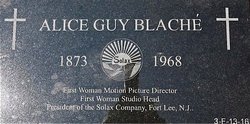
On Sunday July 1st, 2012, the Fort Lee Film Commission unveiled a new grave marker, now in place over the grave of Alice Guy in the Maryrest Cemetery at 770 Darlington Ave. Mahwah, NJ.
The new stone identifies Alice Guy as the first woman filmmaker and the first woman to own her own studio for the production of motion pictures, the Solax Studio in Fort Lee, NJ.
After the unveiling there was a barbecue at the Fort Lee Museum in Fort Lee. In addition to enjoying hamburgers and hot dogs attendees were able to peruse the "Reel Women of Fort Lee," exhibit, which closed at the end of the day. A new exhibit featuring items from Universal Studios will open soon. For updates, check the Fort Lee Historical Society page.
The Fort Lee Film Commission raised the money for the new stone. The text and appearance on the new stone was approved by Alice Guy's surviving American family members.
The new stone will help cemetery tour guides point out Alice Guy's grave to visitors and serve as a focal point for film history buffs who travel around the Fort Lee area to see sites of interest dating from the silent film period.
It was a very hot day, one of many in a heat wave affecting the area this summer, but the heat did not deter us from completing the ceremony and the mountains of flowers looked colorful and fresh. Attending were members of the Fort Lee Film Commission, members of New York Women in Film representing the NYWIFT Film Preservation Fund, as well as scholars such as myself and Professor Richard Koszarski, author of various books about filmmaking in Fort Lee, and members of the general public.
 Gathered Around Grave
Gathered Around Grave
For me the ceremony was particularly moving, as I well remember the day in 1994, when I brought Marquise Lepage, director of The Lost Garden, to visit Alice Guy's grave for the first time. On our first visit we searched for the grave through the entire cemetery, as we assumed she would have a large monument befitting her contribution to the development of cinema. It was with some shock and sadness that we discovered that her grave stone was so simple, with only her name, year of birth and year of death. There was nothing that reflected her pioneering cinematic work.
You can read more about the unveiling in the Fort Lee Patch Article.
The Fort Lee Film Commission has also placed a marker on the site of Alice Guy's Solax studio on Lemoine Ave. in Fort Lee. So, eighteen years after Marquise and I first visited her grave, people touring the cemetery will learn who she was, people who drive down Lemoine Ave will see where her studio was, and hopefully that will lead them to want to know more about Fort Lee's film history.
From the beginning of the twentieth century to about 1918 Fort Lee was the largest and busiest film production center in the United States. By 1920 many of the Fort Lee studios had moved to Hollywood or other parts of the U.S.
There is a detailed history of filmmaking in Fort Lee on the Fort Lee Film Commission website. You can also read about Fort Lee's Film history in various books by Richard Koszarski, among others, or see the documentary, Before Hollywood There was Fort Lee.
In order to make the early film history of Fort Lee more accessible to visitors, the Fort Lee Film Commission is also planning a three screen movie theatre with a walk of fame in front of it. It goes without saying that the first star on the walk, when it is built, will be for Alice Guy.
The Film Commission is now setting up markers on other historical film sites, such as the site of the Fort Lee Universal Film Studios. There is also a Jitney tour.